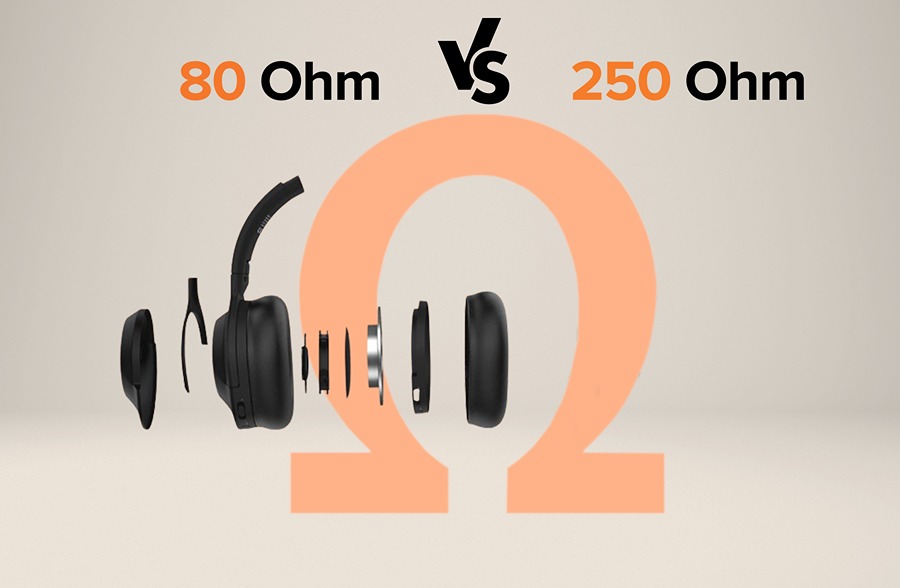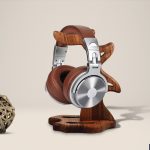
Don’t worry if you’re confused; comprehending such components can be difficult unless you’re into physics.
In today’s article, I’ll do my best to explain what impedance is in audio equipment. and if 80 or 250 impedance is better, so without further ado, let’s decode impedance.
What Exactly is Impedance?
Let’s go step by step.
The first step is to understand what Ohms are.
The amount of Impedance a unit has is measured in Ohms, which is commonly represented by the symbol Ω.
Headphone impedance is commonly rated between 8 to 600 ohms, with 32 ohms becoming more common.
We are all aware that headphones are electronic tools. They employ magnets and other gadgets to produce a variety of sounds.
According to basic physics, every electronic component has some level of resistance.
As a result, Impedance refers to the resistance in the driver unit of headphones.
Simply put, the impedance describes how much current flows through a speaker at a given voltage.
Low impedance, often known as low Ohms, indicates low resistance, while high Ohms indicate high resistance.
If the impedance of a pair of headphones is high, it will require more power to operate, and we will require the assistance of an external amplifier to extract this additional power.
- 16 – 32 OhmS Ω – Low Impedance Range
- 100 OhmS Ω or above – High Impedance Range
Defining Amplifier
While we are here, let’s throw a few words at the definition of an Amplifier so we understand everything regarding Impedance.
I’ll cut a long story short and explain it as simply as possible.
For example, if you take the name “Amplify”, it means boosting or increasing the sound/volume. With that being said, we conclude that an Amplifier is a volume or say sound booster.
Something that is used more often in professional fields.
How Does The Impedance Impact Sound Quality?
Now that you understand what an impedance is, let’s look at how it affects sound quality.
If you were to have a pair of headphones that have a high level of impedance, they will have less distortion at louder levels — Implying a more balanced sound.
On the other hand, if you were to own a pair of headphones with low impedance, they can get more bass response, really bassy and shallow while also having quite a bit of distortion.
For the best sound quality and clarity, audiophiles and professionals should use high impedance headphones.
Distortion
As the name implies, distortion is a process that sound professionals despise.
It happens when the source outputs more power than the headphones can handle, and instead of music, hissing or crackling noises are heard.
There’s also the impedance matching effect, which prevents distortion and gets the most out of your headphones.
Which One Should You Choose 80 ohm or 250 ohm?

Let’s get back to the topic because I feel like I’ve dragged you away from it a little bit, but I made sure to cover every element so you can make better decisions when it comes to buying headphones based on their Impedance.
80 Ohm Headphones
Given the foregoing, we can assume that headphones with an 80 Ohm impedance will have greater bass and less treble. If you turn up the volume, the bass will get louder, something bass heads will love, they just don’t have the right frequency response to produce and mix tracks that are high tier, that’s all to it.
Benefits
⦁ They’re perfect for everyday listening, bass heads, and gamers.
⦁ They can be connected to any phone or desktop and still produce superb sound.
⦁ They aren’t overly loud, but neither too quiet, so their volume won’t hurt your ears.
Is worth knowing that lower Ohm headphones can be used effectively with weaker audio devices like computer or phone speakers, but they will “blow out” when powered by an audio interface or powerful sound card. This implies that if powered by an audio interface, they will sound excessively loud and distorted.
250 Ohm Headphones
Flipping the coin, a 250 Ohm pair of headphones will produce pretty much the same bass since they cover the 80 Ohm spectrum while avoiding the distortion a low ohm headphone can cause. Additionally, they will give you a better sound quality in general.
It’s worth noting that while an amplifier benefits both 80 Ohm and low ohm in general, it’s a must for high impedances like 250 Ohm.
Because there is simply too much power, the amplifier will be required to assist.
Benefits
⦁ The sound quality is excellent.
⦁ This level of impedance will satisfy music professionals and audiophiles due to the wide frequency response.
⦁ The best option for studio work
Frequently Asked Questions

What is the difference between low and high impedance headphones?
Besides the sound quality, the only main difference is that a pair of high impedance headphones will need to withdraw much power from the amplifier, while a pair of low ones will draw less power and can pretty much work without an amplifier.
What is the impedance level of the speakers?
Speakers are typically 16 ohms, 8 ohms, or 4 ohms in impedance. With the 6 and 8 ohms being the norms for most people.
Why is the impedance on speakers way lower than on headphones?
It’s simple, speakers are devices that are much more capable than headsets, meaning they can reproduce the signals at greater volumes.
At what impedance should I get an amplifier?
As I said, any headphones can benefit from the amplifier. Even the 80 Ohm one. However, the low impedance level headphones can work well even without one, I would advise getting an amplifier for any impedance above 60 Ω. So yeah, leave the headphone amps to professionals.
Final Words, Summary
In the end, it all boils down to the type of music you are listening to or doing.
I noted that 32 Ohm is the most common impedance found in most headphones.
Which is a really good amount for listening to music on your phone and desktop.
The 80 Ohms, on the other hand, make it excellent for daily use. It doesn’t matter if you’re gaming, doing regular duties, or working.
It’s all about professionalism when it comes to 250 Ohms. If you’re a professional or an audiophile obsessive with sound, you’ll want to get the 250 ohms.
Further Reading
Know the difference between studio headphones and normal headphones before going further into the key feature such as impedance. For additional information, check out the sound quality between 24 bit 96 kHz.
If you’re about to use the headphones in the shower, find out if IPX5 waterproof is enough for the shower. While converting a song, it’s worth knowing how to convert FLAC to ALAC.
Sound Artist
I’m a Sound Artist creating immersive sonic experiences. I turn everyday objects into music, turning the mundane into something marvellous!





